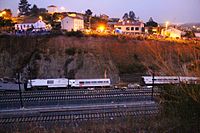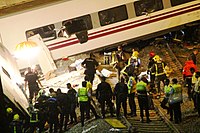Santiago de Compostela derailment
| Santiago de Compostela derailment | |
|---|---|
 Image of rescue efforts | |
 | |
| Details | |
| Date | 24 July 2013 20:41 CEST (UTC+02:00)[1] |
| Location | Angrois, Santiago de Compostela, Galicia |
| Coordinates | 42°51′34.2″N 8°31′40″W / 42.859500°N 8.52778°W |
| Country | Spain |
| Line | Madrid–Ferrol |
| Operator | RENFE |
| Incident type | Derailment |
| Cause | Excessive speed on bend[2] |
| Statistics | |
| Trains | 1 |
| Deaths | 80[3] |
| Injured | 178[4] |
| Damage | 1 train made up of 13 carriages |
The Santiago de Compostela derailment took place on 24 July 2013, when an Alvia high-speed train travelling from Madrid to Ferrol, in the north-west of Spain, left its track at high speed on a curve, about 4 kilometres (2.5 mi) outside of the railway station at Santiago de Compostela. Of the 222 people (218 passengers and four crew) aboard, around 140 were injured and 80 were killed.
The train's data recorder registered a driver's statement that the train was travelling at over twice the posted speed limit of 80 kilometres per hour (50 mph) when it entered a bend in the line. The crash was recorded on a track-side camera, which shows all 10 carriages (2 locomotives and 8 passenger carriages) derail and four overturn.
The crash was Spain's worst rail disaster in nearly 70 years, since the Torre del Bierzo crash in 1944.
Background
Spain has one of the world's most extensive high-speed railway networks, built and maintained by the infrastructure company Adif and run by the state-owned operator RENFE that manages the rolling stock. The RENFE Class 130 passenger train runs on high-speed tracks, but is not the company's fastest train.[5]
Derailment
At 20:41 CEST (18:41 UTC) on 24 July 2013[1][6] a RENFE Class S730 passenger train on an express route from Madrid Chamartín railway station to Ferrol derailed at the end of the Olmedo-Zamora-Galicia high-speed rail line, at Angrois in Santiago de Compostela.[7] All 10 vehicles of the train derailed as the train rounded the A Grandeira Curva; four cars overturned.[7] The trackside camera video indicates that one of the front passenger coaches was the first to leave the rails, followed by other coaches and the engine. The train was carrying 218 passengers at the time of the crash.[1] One of the carriages was torn apart in the accident and another caught fire. Unofficial technical reports disclose that the train was travelling at over twice the posted speed limit when it entered the curve.[8]
According to a Reuters dispatch, 178 people were taken to hospitals. The injured total around 140, with 80 fatalities. As of 25 July, 36 injured were still listed in serious condition.[4] The Santiago de Compostela derailment was the worst train accident in Spain since the Torre del Bierzo rail disaster in 1944.[9][Note 1]
Reaction

Spain's prime minister, Mariano Rajoy, called an emergency ministerial meeting, saying "I want to express my affection and solidarity with the victims of the terrible train accident in Santiago."[10] On 25 July Rajoy visited the area and declared three days of national mourning.[7] King Juan Carlos and Queen Sofia visited injured survivors in hospital at Santiago de Compostela.[3][11] The regional government leader, Alberto Núñez Feijóo, remarked, "There are bodies lying on the railway track. It's a Dante-esque scene".[7] About 320 Spanish national police were dispatched to the scene of the accident. Festivities planned for 25 July, which is a regional holiday (Día Nacional de Galicia), were cancelled.[7]
Investigation
The Comisión de Investigación de Accidentes Ferroviarios is responsible for the investigation of railway accidents in Spain. Núñez Feijóo said it was too early to determine the cause of the accident.[7] A government spokesperson said that all signs pointed to the Santiago de Compostela derailment being an accident and said there was no evidence that terrorism was a factor.[5]
Eyewitnesses said the train was travelling at high speed before derailing.[2][6][12] It has been unofficially reported that the driver, Francisco José Garzón Amo, said he was running the train at 190 kilometres per hour (118 mph), and that the speed limit for that curve was 80 km/h (50 mph).[9] The bend where the accident happened is the first curve reached by a Santiago-bound high-speed train coming from Ourense after an 80-kilometre (50 mi) stretch of high-speed track which is limited to 200 km/h (124 mph). The high-speed track has ERTMS-compliant signalling, but the bend is an upgraded conventional track shared with low-speed trains, and only has the older ASFA signalling system.[13] The data recorder carried on the train registered a driver's statement that the train was travelling in excess of 190 kilometres per hour (118 mph) at the time of the accident.[2]
Gallery
See also
- Amagasaki rail crash, a similar train crash that occurred on a curve at high speed.
- List of rail accidents (2010–present)
- List of Spanish rail accidents
- Valencia Metro derailment (2006)
Notes
- ^ The 2004 Madrid train bombings, which killed 191 people, were an act of terrorism, not an accident.
References
- ^ a b c d "Descarrilo del tren Alvia Madrid-Ferrol" (in Spanish). RENFE. Retrieved 24 July 2013.
{{cite web}}: Unknown parameter|trans_title=ignored (|trans-title=suggested) (help) (Template:Webcite) - ^ a b c "Accidente en Santiago: La caja negra confirma que el tren iba a más de 190 km/h". La Voz de Galicia. Retrieved 24 July 2013.
{{cite web}}: Unknown parameter|trans_title=ignored (|trans-title=suggested) (help) - ^ a b "Spain train crash: Driver faces investigation". BBC News Online. Retrieved 25 July 2013.
- ^ a b "Fatal Spanish train crash probe turns to driver, high speed", Reuters, via CBC.ca
- ^ a b David Roman (24 July 2013). "Train Derailment Kills Dozens in Northwestern Spain". Wall Street Journal. Retrieved 25 July 2013.
- ^ a b David Reinero, Sonia Vizoso (25 July 2013). "77 muertos y más de 140 heridos al descarrilar un tren de pasajeros en Santiago". El Mundo (in Spanish). Retrieved 25 July 2013.
{{cite web}}: Unknown parameter|trans_title=ignored (|trans-title=suggested) (help) - ^ a b c d e f "Dozens die as Spanish train derails in Galicia". BBC News. 25 July 2013. Retrieved 25 July 2013.
- ^ Rodrigo Silva; Antonio Alonso (25 July 2013 – 00:02 CET). "Accidente ferroviario en Santiago de Compostela". El País (in Spanish). Madrid. Retrieved 25 July 2013.
{{cite news}}: Check date values in:|date=(help); Unknown parameter|trans_title=ignored (|trans-title=suggested) (help) - ^ a b "Spain train crash: Galicia derailment kills 78". BBC News. 25 July 2013.
- ^ "Train crash in Spain". Sky News. Retrieved 24 July 2013.
- ^ "Spain's King Juan Carlos visits injured train survivors". BBC News Online. Retrieved 26 July 2013.
- ^ "At least 77 killed as train derails in northern Spain". Russia Today. Retrieved 24 July 2013.
- ^ "Un gran exceso de velocidad al tomar una curva, posible causa del accidente". El País (in Spanish). Retrieved 25 July 2013.
{{cite web}}: Unknown parameter|trans_title=ignored (|trans-title=suggested) (help)





